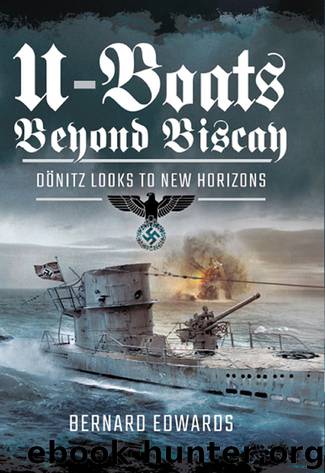U-Boats Beyond Biscay: Dönitz Looks to New Horizons by Bernard Edwards

Author:Bernard Edwards [Edwards, Bernard]
Language: eng
Format: epub, azw3
Publisher: Pen and Sword
Published: 2017-05-30T23:00:00+00:00
CHAPTER EIGHT
East of Gibraltar
Further north, in the Straits of Gibraltar, the waters were a frenzy of threshing propellers. Bletchley Park had intercepted W/T traffic between Lorient and U-boats at sea indicating that the U-boats were about to break into the Mediterranean in force, and everything, including the two 40-year-old armed yachts Rosabelle and Sayonara, had been pressed into service.
Four anti-submarine trawlers were on constant patrol, steaming in line abreast 1½ miles apart, sweeping the Straits from end to end and keeping a constant visual and Asdic watch. Amongst them was HMT Lady Shirley, back in service after two months in Gibraltar under repair. Lieutenant Commander Arthur Callaway was still in command, and the trawler’s crew was largely unchanged, except that the gaps left by the gunfight with U-111 off the Canaries had been filled. There had been only one change in her officers, Sub Lieutenant Allan Waller being replaced by Lieutenant Patrick Hardinge-Katon. Waller, hospitalized for further treatment of wounds received when the trawler Tourmaline was bombed and sunk in January 1941, had been seconded to the staff of Admiral Edwards-Collins and was in charge of Gibraltar’s U-boat plot.
All this extra activity off Gibraltar was well meant, but it was too little, too late. A number of U-boats had already slipped through the Straits and had been in the Mediterranean for some months.
Towards the end of August 1941, the German Naval High Command, at the behest of Hitler, and despite the vociferous protests of Admiral Dönitz and his C-in-C Grand Admiral Raeder, had ordered the transfer of U-boats from the North Atlantic to the Mediterranean. They were to be based at Salamis in southern Greece to operate against British convoys supplying the Eighth Army in North Africa.
When Italy entered the war on the side of Germany in June 1940, Mussolini saw a not-to-be-missed opportunity to recreate the old Roman Empire in North Africa which had once stretched from Morocco to the Red Sea. He ordered General Graziani, who commanded a force of 200,000 motorized troops in Italian-occupied Libya, to move eastwards and cross the frontier into Egypt. The British garrison in Egypt, heavily outnumbered, was forced into a headlong retreat. Within three days, Graziani was 70 miles deep into Egypt and at the gates of Sidi Barani. Here, possibly astounded by the ease of his advance, the General called a halt to consolidate.
This unexpected lull in the fighting gave the British troops, led by the experienced General Wavell, an opportunity to recover from the humiliation of their forced retreat and to regroup. Reinforced, they then launched a fierce counter-attack, pushing the Italians back into Libya. Graziani’s men had no stomach for a fight on equal terms, and their retreat soon became a rout. Sidi Barani fell to Wavell, followed by Bardia, Tobruk, Derna and Benghazi. By early February 1941 the British were 300 miles into Libya and Mussolini was begging Hitler for help.
General Erwin Rommel’s Afrika Korps landed in North Africa in late February, and the battle-hardened German troops took charge of the rapidly deteriorating situation in the Western Desert.
Download
U-Boats Beyond Biscay: Dönitz Looks to New Horizons by Bernard Edwards.azw3
This site does not store any files on its server. We only index and link to content provided by other sites. Please contact the content providers to delete copyright contents if any and email us, we'll remove relevant links or contents immediately.
| Africa | Americas |
| Arctic & Antarctica | Asia |
| Australia & Oceania | Europe |
| Middle East | Russia |
| United States | World |
| Ancient Civilizations | Military |
| Historical Study & Educational Resources |
The Radium Girls by Kate Moore(11642)
100 Deadly Skills by Clint Emerson(4704)
The Templars by Dan Jones(4562)
Rise and Kill First by Ronen Bergman(4554)
The Doomsday Machine by Daniel Ellsberg(4254)
The Rape of Nanking by Iris Chang(4029)
Killing England by Bill O'Reilly(3901)
Hitler in Los Angeles by Steven J. Ross(3804)
Stalin by Stephen Kotkin(3732)
12 Strong by Doug Stanton(3424)
Hitler's Monsters by Eric Kurlander(3174)
Blood and Sand by Alex Von Tunzelmann(3066)
Darkest Hour by Anthony McCarten(3019)
The Code Book by Simon Singh(2878)
The Art of War Visualized by Jessica Hagy(2846)
Hitler's Flying Saucers: A Guide to German Flying Discs of the Second World War by Stevens Henry(2631)
Babylon's Ark by Lawrence Anthony(2438)
The Second World Wars by Victor Davis Hanson(2425)
Tobruk by Peter Fitzsimons(2381)
